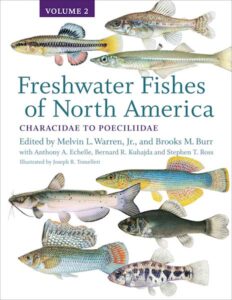 For the number of species within the category deemed to be of conservation concern, the amount of attention paid – particularly by the general public – to the world’s freshwater fishes is breathtakingly small. Unless a species is of interest to the sporting community or aquarist hobbyists, is introduced to a new area where it is identified as a threat to the native species or deemed a nuisance to the local humans, or its existence in a particular geographic location involves it in a legal dispute, the outcome of which could ensure or prevent a large corporation from increasing its profits, one rarely hears or reads much news pertaining to the planet’s freshwater fish species.
For the number of species within the category deemed to be of conservation concern, the amount of attention paid – particularly by the general public – to the world’s freshwater fishes is breathtakingly small. Unless a species is of interest to the sporting community or aquarist hobbyists, is introduced to a new area where it is identified as a threat to the native species or deemed a nuisance to the local humans, or its existence in a particular geographic location involves it in a legal dispute, the outcome of which could ensure or prevent a large corporation from increasing its profits, one rarely hears or reads much news pertaining to the planet’s freshwater fish species.
Not surprisingly, much of this anonymity arises from the fact that most people, and even a sizable portion of those whose work is the study of aquatic ecosystems and the species living in them, are unfamiliar with the vast majority of the species of fishes that inhabit the world’s freshwater lakes, rivers, and streams. And as any student of conservation communication will tell you, people aren’t interested in preserving what they don’t value, and in order to value something, it must be known to exist in the first place.
For those curious to discover just how many and remarkably varied are the freshwater fish species to be found in North American waters, no book, or series of books, of which I have ever been aware can rival the landmark series initiated by Johns Hopkins University Press in 2014 with their publication of Freshwater Fishes of North America, Volume 1: Petromyzontidae to Catostomidae. Edited by Melvin L. Warren Jr. and Brooks M. Burr, with illustrations by Joseph R. Tomelleri, this inaugural volume featured the work of twenty-three different expert authors representing a variety of universities, research laboratories, museums, and aquariums. Not surprisingly, it has since garnered widespread praise from the professional and serious amateur communities alike.
Now, six years after the publication of that first volume, the enthusiastically awaited second volume has been added to the series: Freshwater Fishes of North America, Volume 2: Characidae to Poeciliidae. With this volume, three new members have joined the original Volume 1 editorial team of Warren and Burr: Anthony A. Echelle, Bernard R. Kuhajda, and Stephen T. Ross. The illustrations are once again by Joseph R. Tomelleri, but the number of contributing authors has increased to thirty-five.
As in the first volume, this new second one – already pronounced to be a “heroic undertaking in its scope” by one early reviewer, provides an “authoritative synthesis covers the ecology, morphology, reproduction, distribution, behavior, taxonomy, conservation, and the fossil record of [each of] the included North American fish families.” From the characins (I didn’t know what they were either at first but after reading about them in the book I discovered that a five of them once lived in a twenty gallon tank in the corner of my childhood bedroom) and North American catfishes to the pupfishes and livebearers, if it falls within these taxonomic families and has been found in bodies of freshwater in North America, a wealth of information can be found regarding it within the between the covers of this remarkable book.
If you enjoyed reading this, please consider signing up for The Well-read Naturalist's newsletter. You'll receive a helpful list of recently published reviews, short essays, and notes about books in your e-mail inbox once each fortnight.
